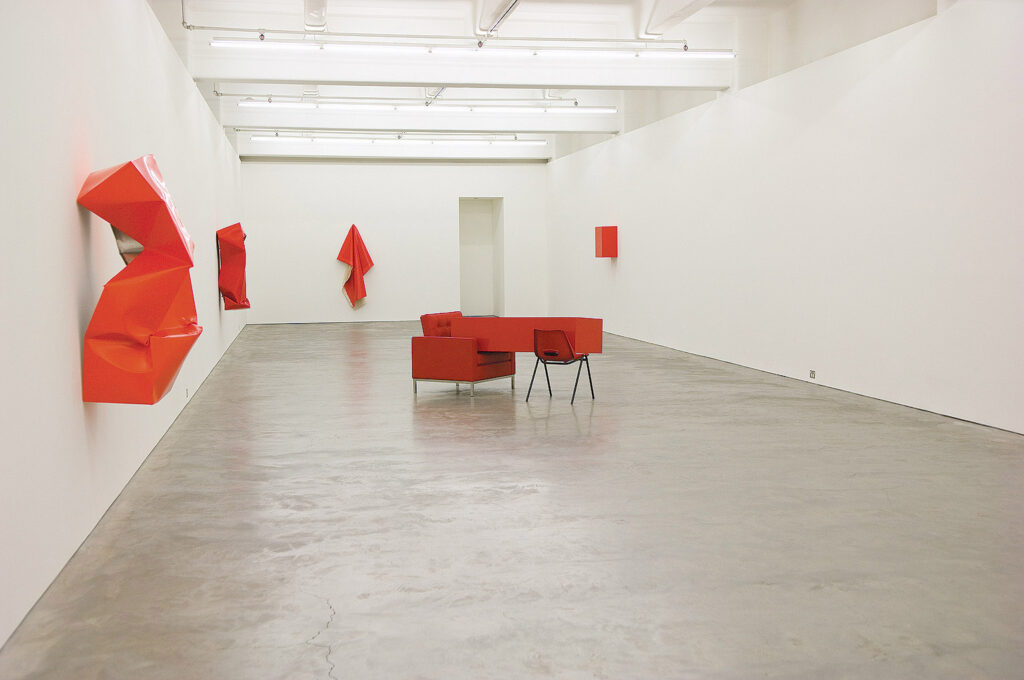
Angela De La Cruz
Transfer
Anna Schwartz Gallery, Melbourne
4 February – 17 March 2012
Angela De La Cruz’s monochromatic compositions begin at the site of the Minimalist object which attempts to represent nothing beyond itself. From this sense of presence, De La Cruz speaks toward Otherness through the receptivity of chance and uncertainty, allowing the beauty of the encounter to be defined as the cross between a thinking in sensibility and an experience shaped by the uncertainty of discourse.
Compressed (Orange) and Compressed (Red) 2011 resemble Donald Judd-style boxes, that have encountered some sort of external pressure, some force that has squeezed and pressed down onto the hollow rectangular containers. Each of the aluminium boxes has responded differently to the motion of compression with sections forced both inwardly and out — creating a fault line of curves, crevices and folds that shift the Minimalist object away from its geometric precision and stiff rigidity, towards something more than that of its own materiality. While these works may look like Judd’s prefabricated boxes damaged whilst in transit, other works in the exhibition seem to have broken down, been reconfigured, or have had some misfortune set upon them.
Extension 3 (Red/Orange) 2011 consists of two paintings. The first is a flawlessly painted red rectangle with a slim orange border; beneath it is its twin, except that has been torn in half, revealing its dismantled frame. Positioned at the far end of the gallery space is a larger monochrome painting that suggests the scale of a human body. Deflated 21 (Red) 2011 is a painting that has been completely removed from its timber frames — it has lost its support, and is only held to the wall from a single position at its top, allowing the canvas to fold and drape downward.
This process of breaking down and tearing apart is akin to slapstick — like a person confidently striding, only to slip on a banana peel. In Scratch 1 (Red) 2011 a lush monochrome painting has a nasty scratch that runs across the bottom. The painting is hung low, suggesting that this decision could well be the cause for why this painting will never reach the Minimalist standard. Similar to a Dale Frank painting, where the lush and layered varnish has been disturbed by the odd bug, in De La Cruz’s work the phenomenological experience cannot be bracketed off, the mess of life cannot be withheld.
Within the painting Dirty 5 (Red) 2011, the rational order of the monochromatic square is disrupted by a splatter of paint, a disturbance to geometric order, a flurry of abstraction. To face Dirty at Anna Schwartz Gallery could have meant turning away toward the entrance and noticing the busy city street life going on outside the gallery. The doorway to the space, like the monochrome square of Dirty, frames off something beyond representation, suggesting something that is beyond our grasp. For this exhibition, exteriority operates from within a structure: the expression towards experience doesn’t flood the codes of representation, but, rather, speaks from within them. The beauty in the uncertainty of Otherness, the mess and misfortune in life, is not attempted to be owned or comprehended, but is here presented as irreducible.
The installation Transfer (Red) 2011 stands apart from the rest of the exhibition. Centrally placed toward the entrance of the space, Transfer (Red) consists of two styles of chair, one a plush armchair representing high modernist design and the other a common plastic stacking chair. Lying across the two chairs is a Robert Morris-style rectangular column. All three of these objects share the same ‘letter box’ colour red, unifying the composition and bridging the gap between minimal design as ideal form, and minimal art as self-referential. Unified and isolated, devoid of the clutter and the mess of life, the stillness of Transfer (Red) has the chairs deemed pallbearers that now carry the coffin.
The unifying use of the single colour red or the single colour orange, puts an emphasis on the material of the art object. However, to this pure experience of colour and material, De La Cruz adds the randomness of chance and uncertainty, so that the sensibility of phenomenology doesn’t generalise Otherness, but instead speaks out towards an inter-subjectivity.
